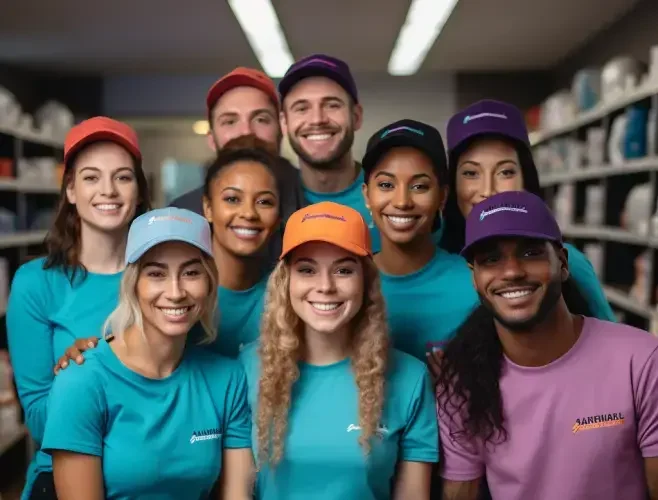Creating Unique Custom Branded Merchandise for Your Business
In today’s fast-paced business world, it’s more important than ever to stand out from the crowd. One way to do this is through creating unique and custom branded merchandise for your business. By doing so, you can boost your brand recognition, enhance customer loyalty, and increase revenue opportunities. In this article, we’ll explore the importance of custom branded merchandise, how to identify your target audience, choosing the right products, and designing your custom merchandise to get the most out of your efforts.
Understanding the Importance of Custom Branded Merchandise
Custom branded merchandise is an essential tool for modern businesses. With so much competition, establishing a unique and recognizable brand is more important than ever. Branded merchandise is a fantastic way to promote your brand and enhance recognition amongst potential customers. Not only that, but it can also help to strengthen customer loyalty by ensuring that your brand remains top-of-mind.
However, the benefits of custom branded merchandise go beyond just promoting your brand. It can also be a way to connect with your customers on a deeper level and create a sense of community around your brand.
Boosting Brand Recognition
Branded merchandise offers a unique opportunity to get your name out there. Every time someone wears your branded t-shirt, drinks from your branded mug, or uses your branded pen, they are promoting your brand without even realizing it. This can lead to increased visibility and exposure for your business, helping to build brand recognition and awareness.
But the benefits of brand recognition go beyond just getting your name out there. It can also lead to increased credibility and trust amongst potential customers. When people recognize your brand, they are more likely to trust your products or services, which can lead to increased sales and revenue.
Enhancing Customer Loyalty
Custom branded merchandise is also an effective way to enhance customer loyalty. Giving away branded merchandise to customers who make a purchase can help to foster a sense of appreciation and gratitude. It shows that you value their business and want to keep them coming back. Customers who feel appreciated are more likely to become repeat buyers and recommend your brand to others.
In addition to giving away branded merchandise, businesses can also create exclusive merchandise for their loyal customers. This can create a sense of exclusivity and make customers feel like they are part of a special community. By creating a sense of community around your brand, you can create a loyal customer base that will continue to support your business for years to come.
Increasing Revenue Opportunities
In addition to boosting brand recognition and loyalty, custom branded merchandise can also create new revenue opportunities. By selling branded merchandise such as t-shirts, hats, and other accessories, businesses can generate additional income streams. Not only does this help to increase revenue, but it can also create a deeper connection between your brand and your customers.
But selling branded merchandise doesn’t have to be limited to just physical products. Businesses can also sell digital merchandise such as wallpapers, social media graphics, and other digital assets. This can be a great way to generate revenue without having to worry about inventory or shipping costs.
In conclusion, custom branded merchandise is an essential tool for modern businesses. It can help to boost brand recognition, enhance customer loyalty, and create new revenue opportunities. By investing in custom branded merchandise, businesses can create a deeper connection with their customers and establish a unique and recognizable brand that will stand out in a crowded marketplace.
Identifying Your Target Audience
Before you start creating custom branded merchandise, it’s important to identify your target audience. Understanding your target audience is essential to ensure that your merchandise resonates with your customers and achieves your desired results.
When it comes to identifying your target audience, there are several factors to consider. One of the most important factors is demographics. Demographics include age, gender, income, education level, and occupation. By analyzing these factors, you can gain insight into who your target audience is and what their needs and preferences might be.
Another important factor to consider is psychographics. Psychographics include things like interests, values, opinions, and attitudes. By understanding these factors, you can create merchandise that speaks directly to your target audience and meets their specific needs and preferences.
Analyzing Customer Needs and Preferences
Once you have a good understanding of your target audience’s demographics and psychographics, it’s time to analyze their needs and preferences. What problems do they have that your product or service can solve? What features or benefits matter most to them? What types of merchandise are they most likely to use and appreciate?
By answering these questions, you can create merchandise that is tailored to your target audience’s needs and preferences. This will help ensure that your merchandise is well-received and that it achieves your desired results.
Aligning Your Merchandise with Your Brand Identity
Finally, it’s essential to align your merchandise with your brand identity. Your merchandise should reflect your brand’s values, mission, and personality. This creates consistency and reinforces your brand’s message, helping to build a stronger connection with your customers.
For example, if your brand is focused on sustainability and eco-friendliness, you might consider creating merchandise that is made from recycled materials or that promotes environmental awareness. This not only aligns with your brand’s values but also helps to attract customers who share those values.
Overall, identifying your target audience is an essential step in creating successful custom branded merchandise. By understanding your target audience’s demographics, psychographics, needs, and preferences, you can create merchandise that resonates with your customers and helps to build a stronger connection with your brand.
Choosing the Right Products for Your Custom Merchandise
Once you’ve identified your target audience and analyzed their needs and preferences, it’s time to choose the right products for your custom merchandise. The right products can help to ensure that your merchandise is used and appreciated by your customers.
When it comes to selecting the right products for your custom merchandise, there are a variety of options to consider. From apparel and accessories to tech gadgets and electronics, eco-friendly and sustainable options, and even novelty items and collectibles, the possibilities are endless.
Apparel and Accessories
Apparel and accessories are popular choices for custom branded merchandise. T-shirts, hats, and bags are items that people use frequently, making them an excellent opportunity to promote your brand. Plus, these items tend to have a longer lifespan than other types of merchandise, providing ongoing exposure for your brand.
When selecting apparel and accessories for your custom merchandise, it’s important to consider the quality of the items. You want to choose items that are well-made and will hold up over time. Additionally, you’ll want to think about the design of the items. Choose colors and styles that are on-trend and will appeal to your target audience.
Tech Gadgets and Electronics
Tech gadgets and electronics are another category of merchandise that are popular among customers. Items like USB drives, phone cases, and laptop sleeves not only look great but can also be useful to your customers, creating a positive association with your brand.
When selecting tech gadgets and electronics for your custom merchandise, it’s important to consider the functionality of the items. You want to choose items that are useful and relevant to your target audience. Additionally, you’ll want to think about the design of the items. Choose items that are sleek and modern, with clean lines and a minimalist aesthetic.
Eco-Friendly and Sustainable Options
Eco-friendly and sustainable options have become increasingly popular in recent years. Using sustainable materials such as bamboo or recycled plastic can help to demonstrate your brand’s commitment to environmental responsibility.
When selecting eco-friendly and sustainable options for your custom merchandise, it’s important to consider the materials used in the items. Choose materials that are renewable, biodegradable, or recycled. Additionally, you’ll want to think about the design of the items. Choose items that are simple and understated, with a focus on natural materials and textures.
Novelty Items and Collectibles
Finally, novelty items and collectibles can be a fun way to create buzz around your brand. Items like stickers, keychains, and magnets can be used as giveaways or sold as part of a limited edition promotion.
When selecting novelty items and collectibles for your custom merchandise, it’s important to consider the uniqueness of the items. Choose items that are quirky and fun, with a focus on humor or pop culture references. Additionally, you’ll want to think about the design of the items. Choose items that are eye-catching and colorful, with bold graphics and typography.
By selecting the right products for your custom merchandise, you can create a lasting impression on your customers and promote your brand in a meaningful way. Consider your target audience and their needs and preferences, and choose items that will resonate with them and create a positive association with your brand.
Designing Your Custom Branded Merchandise
The final step in creating unique custom branded merchandise is designing your merchandise. Your design should aim to create a lasting impression on your customers and should be visually appealing and consistent with your brand identity.
Incorporating Your Logo and Brand Colors
Your logo and brand colors are essential elements of your brand identity and should be incorporated into your design. Your logo should be prominent and easily recognizable, while your brand colors should be used to create a cohesive and recognizable visual identity.
When incorporating your logo and brand colors, it’s important to consider the context in which your merchandise will be used. For example, if you are designing merchandise for a sports team, you may want to use bold, bright colors that will stand out on the field or court. On the other hand, if you are designing merchandise for a more professional setting, you may want to use more muted, sophisticated colors that convey a sense of professionalism and expertise.
Selecting the Right Typography and Imagery
The typography and imagery you choose can also help to reinforce your brand identity. Select fonts and imagery that support your brand’s personality and style, creating consistency across all brand materials.
When selecting typography, consider the legibility of the font and how it will look when scaled up or down. You may also want to consider using a custom font that is unique to your brand, which can help to make your merchandise even more distinctive.
When selecting imagery, consider the message you want to convey and the emotions you want to evoke. For example, if you are designing merchandise for a charity, you may want to use images that convey a sense of compassion and caring. Alternatively, if you are designing merchandise for a music festival, you may want to use images that convey a sense of energy and excitement.
Balancing Aesthetics and Functionality
Finally, it’s important to balance aesthetics and functionality when designing your custom branded merchandise. Your merchandise should look great, but it should also be practical and useful to your customers. By finding the right balance between aesthetics and functionality, you can create merchandise that your customers will want to use and wear regularly.
When designing merchandise, consider the intended use of the item. For example, if you are designing a t-shirt, you may want to consider the fit, fabric, and durability of the shirt. If you are designing a tote bag, you may want to consider the size and weight of the bag, as well as the durability of the straps.
By designing merchandise that is both visually appealing and practical, you can create a lasting impression on your customers and build a strong brand identity that they will remember for years to come.
Conclusion
Creating unique custom branded merchandise can be an excellent way to promote your brand and enhance customer loyalty. By understanding your target audience, identifying the right products, and designing merchandise that is visually appealing and consistent with your brand identity, you can create merchandise that creates a lasting impression on your customers.


